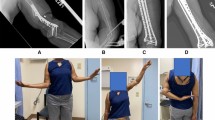Abstract
Background. People with metastatic fracture of the humerus are of poor general health. Often they are not able to compensate the handicap of an impaired extremity. Standard osteosynthetic techniques are not always applicable. To reduce the trauma of the operation, we used the Fixion® expandable nail system.
Methods. At two centers, 23 metastatic fractures of the humerus (in 22 patients) were stabilized with a new nailing system. The nail expands under hydraulic pressure up to 150% of its uninflated diameter, gaining long frictional contact to the bone. All patients were followed up until osseous healing occurred or until they died.
Results and conclusions. The operative time was approximately 32 min, including 1.4 min fluoroscopy time. Nail insertion is brief and therefore not very stressful to the group of debilitated patients who require this intervention. Immediately postoperatively, the upper extremity is stable to permit physiotherapy. In these few patients, we saw no complications. The advantages of the surgical approach appear to outweigh those of conservative management options if a simple and safe surgical technique makes the humerus stable enough to resist normal daily loads.
Similar content being viewed by others
Author information
Authors and Affiliations
Additional information
Electronic Publication
Rights and permissions
About this article
Cite this article
Franck, .W., Olivieri, .M., Jannasch, .O. et al. An expandable nailing system for the management of pathological humerus fractures. Arch Orthop Trauma Surg 122, 400–405 (2002). https://doi.org/10.1007/s00402-002-0428-1
Received:
Issue Date:
DOI: https://doi.org/10.1007/s00402-002-0428-1




